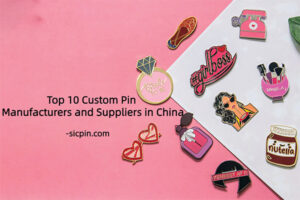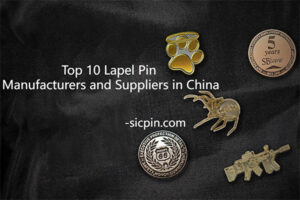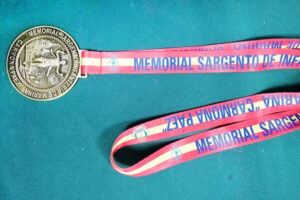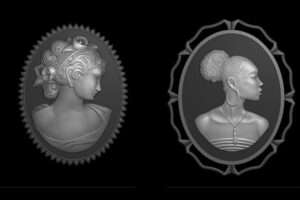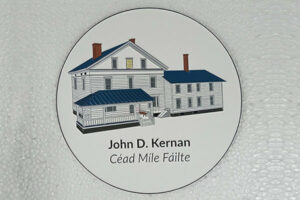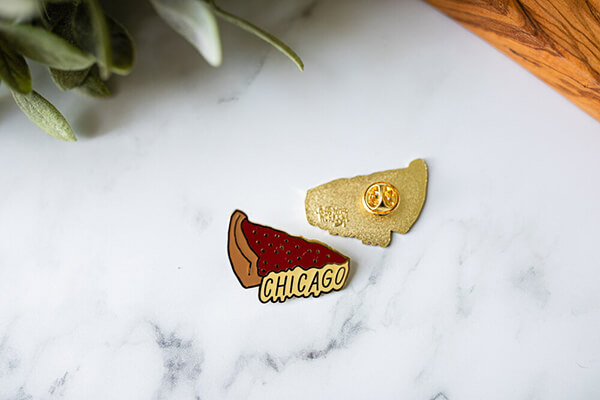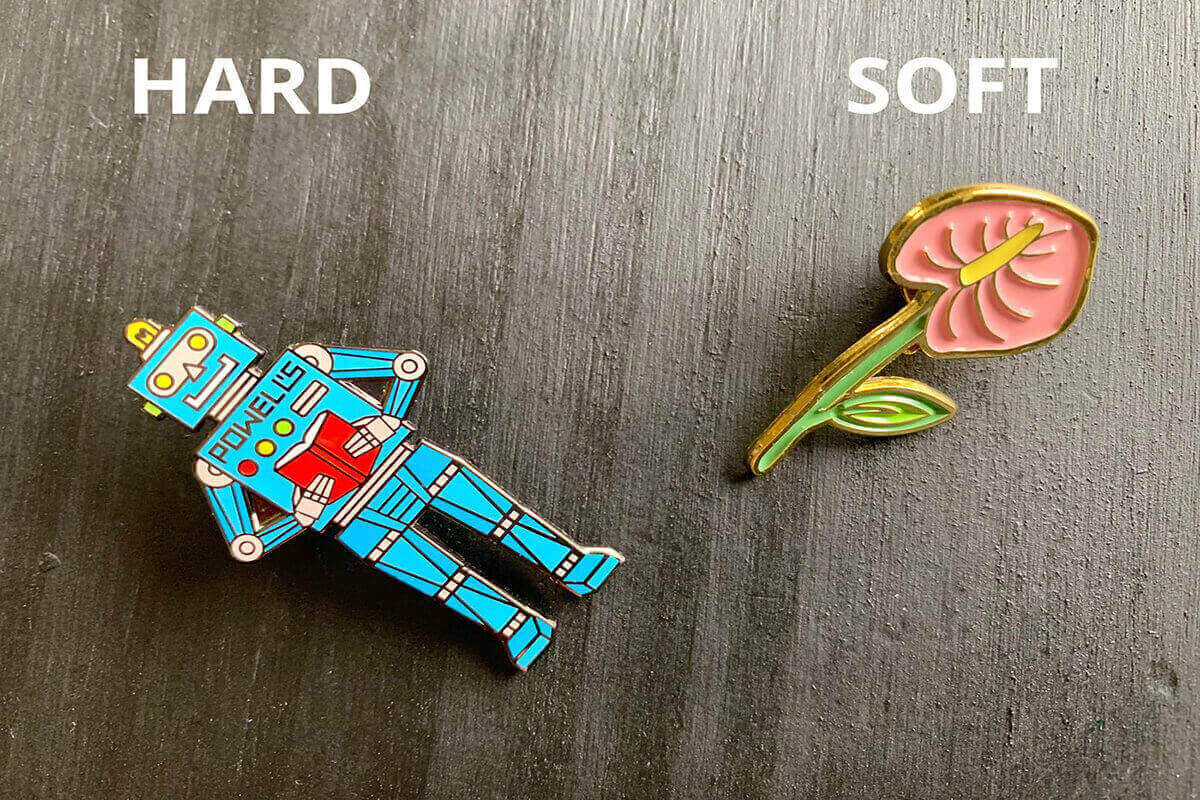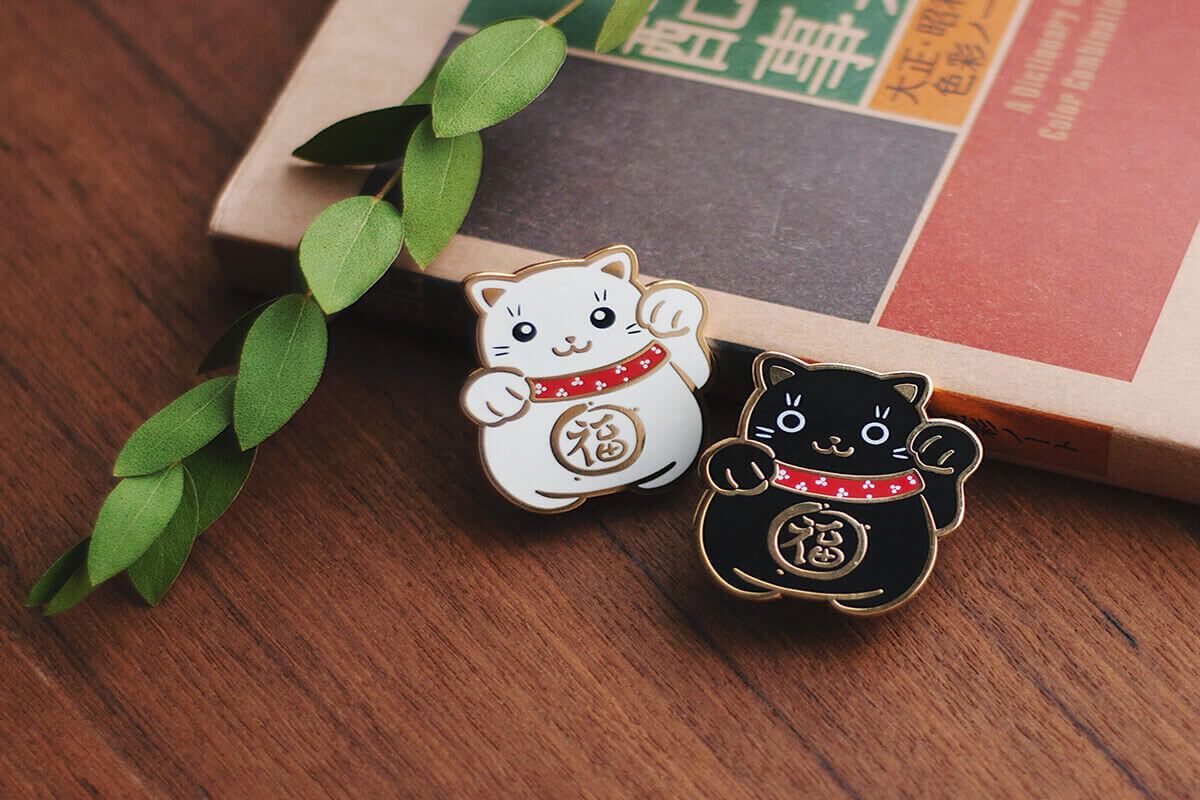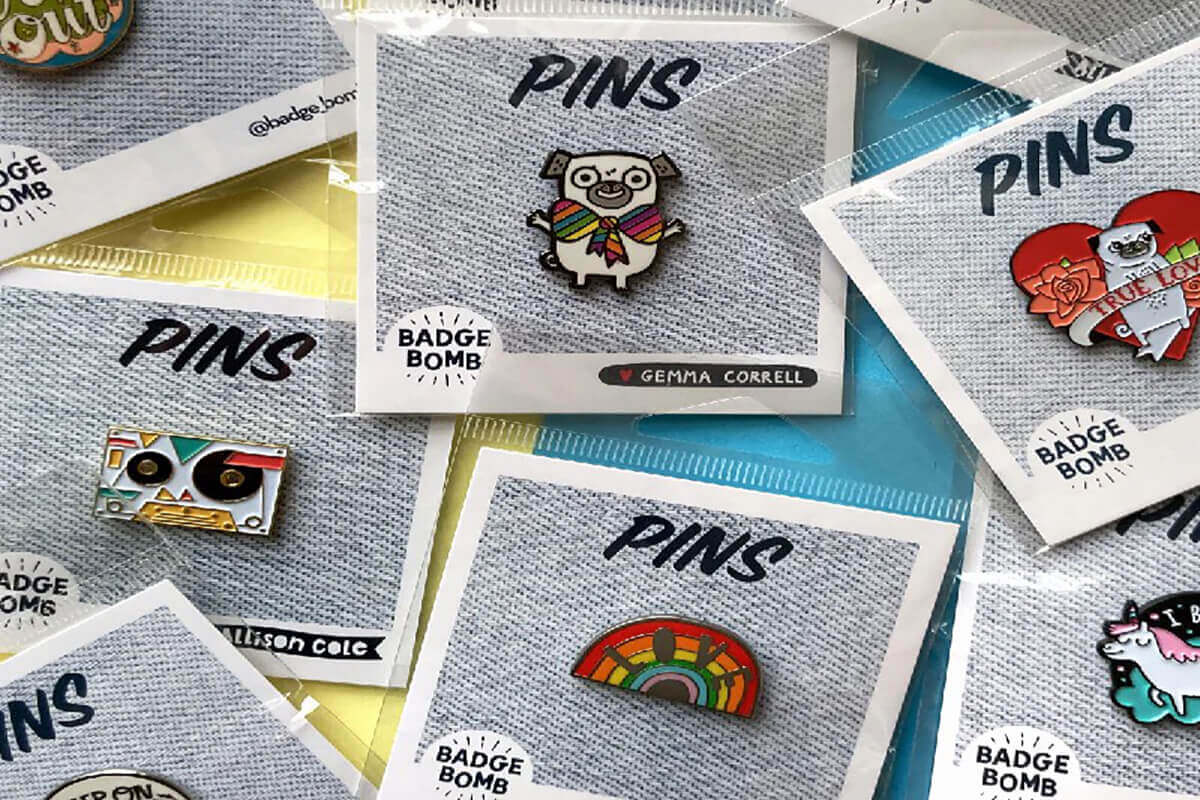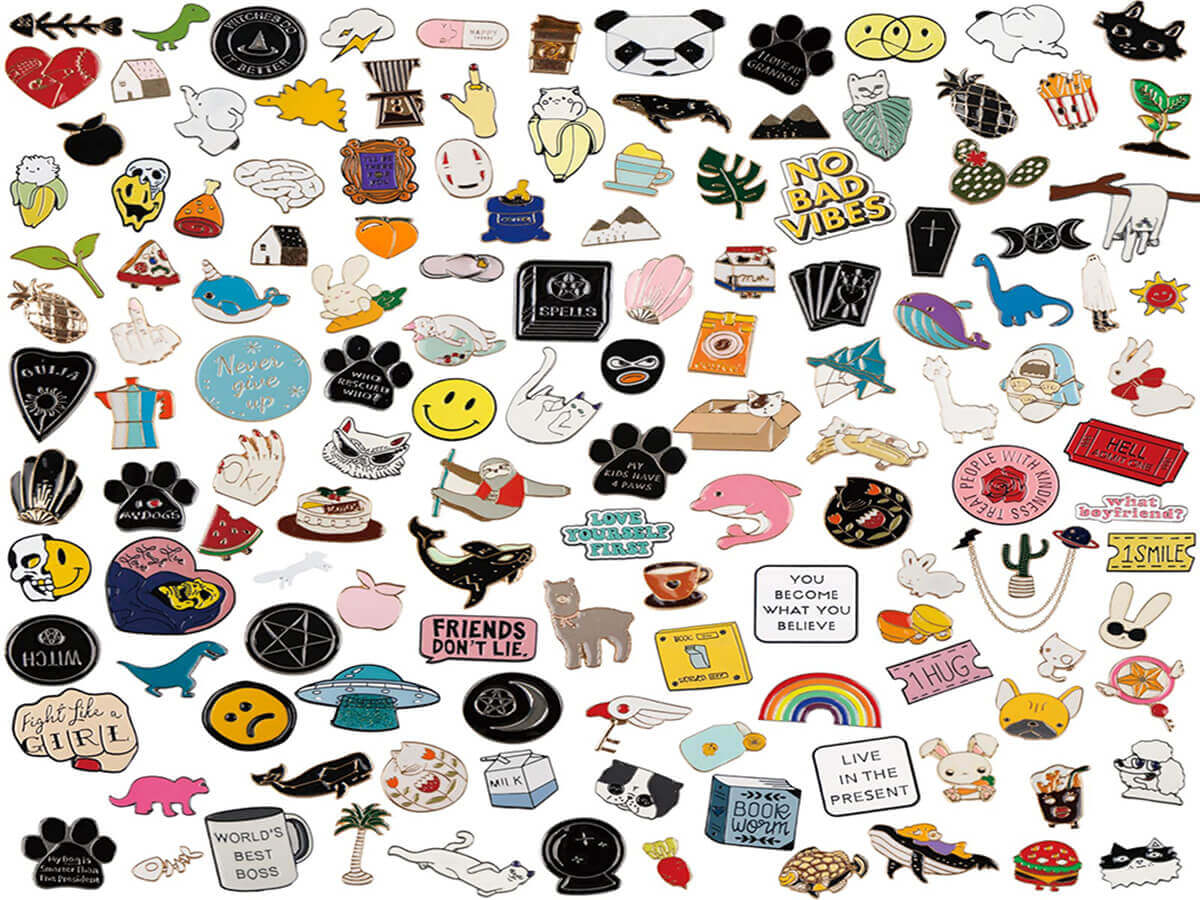The material you use will not only affect the overall appearance of the enamel pin, but also the color, cost, and perceived quality of the pin. Choose the right material and your pins may be durable, stylish, and an instant seller; choose the wrong material and your pins may be flimsy, cheap-looking, and really hard to move.
At Sicpin we offer a wide range of materials for you to choose from for your pins. In today’s guide, we’ll look at the different types of enamel pin materials that are suitable for making them. Read on to learn more.
1. Enamel options
Metal and enamel paint are used to make enamel pins. Enamel paints are solvent-based paints that dry to a hard, opaque, often glossy surface. It is a popular pin choice because it is strong, durable, and vibrant.
When choosing a material for your enamel pins, you have two types to choose from: hard enamel and soft enamel. While these pins are actually made from the same type of enamel, their production process results in a slightly different look and feel.
The most traditional type of pin is the soft enamel pin. When making soft enamel pins, liquid enamel paint is poured into the grooves of the stamped metal before baking and hardening. The pouring process creates valleys, resulting in a smooth, textured surface. Soft enamel pins are not soft to the touch – once baked, they are hard and durable, although slightly less so than hard enamel pins. They are an excellent choice for more detailed designs. It is the most affordable type of enamel pin to purchase soft enamel pins.
Hard enamel pins are made by adding a single piece of colored enamel to a stamped metal mold, baking the pin, and then polishing and grinding the pin to create a smooth, flat surface. Hard enamel pins are generally thicker and more durable than soft enamel pins, but they cannot support the same level of detail as soft enamel pins. Due to the higher quality and complex production process, the cost of hard enamel pins is slightly higher than that of soft enamel pins.
(Another related product guide: Best 15 Enamel Tie Pins of 2023)
2. Which type of enamel is best for my pin?
The best type of enamel to choose for your enamel pin depends on your pin design, budget, and general preferences. If your pin design is fairly detailed, soft enamel pins may be more suitable. But if you prefer a color-block style and prefer a smooth surface, then hard enamel pins are definitely the way to go.
If you’re on a tight budget, custom soft enamel pins usually cost less than custom hard enamel pins. But if you’re looking for the absolute highest quality and are willing to spend a little more to get it, go for custom hard enamel pins.
1) Metal options
If you create a 3D molded or molded pin, the type of metal you choose will determine the look and feel of the entire pin. But even if you have your heart set on making an enamel pin, you still have to choose the type of metal you want for your enamel pin base and outline. Here are 14 different types of metal and finish options you can choose from for your pins:
- Shiny Gold – Shiny gold pins feature a metallic gold finish with a polished surface.
- Shiny Gunmetal – Shiny gunmetal pin features a metallic dark gray finish with a polished surface.
- Shiny Silver – Shiny silver pins feature a classic silver finish with a polished finish.
- BLACK PAINT – The metal base of the black paint pins is coated in black paint for a full matte finish.
- Shiny Nickel – Shiny Nickel pins feature a silver finish and polished surface.
- Antique Gold – Antique gold pins feature a gold finish with a distressed finish for a distressed effect.
- Antique Silver – Antique silver pins feature a silver finish with a distressed surface for a distressed effect.
- Shiny Rose Gold – Shiny rose gold pins feature a rose gold finish with a polished surface.
- Shiny Brass – Shiny brass pins come in both a brass finish and a polished finish.
- Antique Brass – Antique brass pins feature a brass finish with a distressed finish for a distressed effect.
- Antique Nickel – Antique Nickel pins feature a silver finish and distressed surface to add a distressed effect.
- Shiny Copper – Shiny copper pins feature a copper finish and a polished finish.
- Antiqued Bronze – Antiqued Bronze Pins feature a copper finish that has been distressed for a distressed finish.
- Brushed Brass – Brushed brass pins feature a brass finish with a brushed finish for a rough, distressed look.
(Another related product guide: Enamel Pin Backs: All You Need to Know)
2) Which metal is best for my pins?
The type of metal and finish that’s best for your pins will depend on your intended design, aesthetic, and color palette. Since enamel pins often come in a variety of bright colors, you’ll want to consider how different metallic color options will match the rest of your design. That being said, all of the available metals and finishes are high-quality options – the decision about this material comes mostly down to taste.
Some metal/finish options are not compatible with hard enamel pins due to the grinding and polishing process involved. If you plan to make a hard enamel pin, you won’t be able to choose metal with an antique finish or a black paint coating. Soft enamel pins are compatible with all metal/finish options.
Please note that all of the above metal and finish customization options are available free of charge, with the exception of Shiny Silver and Antique Silver.
3. Combine materials in enamel pins
Have trouble choosing between two different metal or finish colors? unnecessary! Some manufacturers offer the option of mixing two identical finish metal colors to create a multi-tonal base. This means you can choose any two metal colors (such as gold, silver, brass, or rose gold) to combine in one pin, as long as they have the same finish (such as shiny or antique). For example, you might choose to combine antique silver and antique gold, but not shiny brass and antique nickel.
You may notice the contrast created by combining two different colors of metal in a molded or 3D molded pin, but this is also an option with hard or soft enamel pins.
Note that all enamel pins essentially combine two materials into one pin: metal and enamel.
(Another related product guide: Enamel Pin Back Buying Guide)
4. Enamel pin backing attachment
Your enamel pin backing attachments may not have much of an impact on how your pins look on your jacket or backpack, but they can have a significant impact on the functionality and perceived quality of your pins. After all, your customers aren’t just looking for pins with eye-catching designs – they also want to be confident that their pins won’t fall off or fall apart.
8 different enamel pin backing attachment options are available below:
- Butterfly Clutch Backing – The butterfly clutch is the most traditional type of pin backing. The product is lightweight, durable, and easy to install and remove. The traditional butterfly clutch is metal.
- Black Rubber Clutch Backing – This type of pin backing is similar in shape and function to a butterfly clutch, but the pin backing is secured with a round black rubber seal.
- Yellow Rubber Clutch Backing – This type of pin backing is similar to the black rubber clutch, except the backing is bright yellow for easier identification.
- Deluxe Clutch Backing – The Deluxe Clutch is a higher quality version of the traditional butterfly clutch. The deluxe clutch features a brushed metal finish for a more upscale look.
- 2-Piece Magnet Backing – This pin backing consists of two parts – a magnetic backing that permanently attaches to the pin, and a small round magnet that holds the pin in place.
- Bar Magnet Backing – Similar to the 2-piece magnet backing, this pin backing uses larger bar magnets for a stronger hold.
- Safety Pin – This pin backing uses traditional gold safety pin backing to hold the pins in place.
- Bendable Legs – The bendable metal legs of this pin backing allow the pin to be attached directly to the button.
(Another related product guide: Enamel Pin Backing Cards:A Full Guide)
1) What type of backing attachment is best for my pins?
All of the above backing attachment options are durable and easy to install and remove. The type of backing attachment that is best for your pin depends on its design and intended use.
For example, a magnet backing may be better for a name tag that needs to be put on and off frequently, a traditional clutch pin backing may be better for a more permanent pin, and if your pins will wear out, a curved leg backing may be the best tie-in. Button your shirt. Be sure to consider the size of your pins – some larger pin backings (such as safety pins or bar magnet backings) may not fit very small pins.
All pin backing options are compatible with all pin types including hard and soft enamel pins.
5. Other pin material options
But wait, that’s not all! Once you determine the type of enamel, metal, and backing attachment you want for your pins, you can add optional materials as needed, including:
- Glitter, luminous, or translucent enamel
- Additional support attachments for stability
- protective coating
- rhinestones
- Aluminum core metal reduces pin weight
You can also choose to add embossing, engraving, sandblasting, or debossing to change the look of your pin.
(Another related product guide: How To Clean and Maintain Enamel Pins)
6. Conclusion
That’s it for this guide summarizing the materials for making different types of pins. After reading this article, you should have a better understanding of enamel pins, and hurry up to customize the pins you want.
How useful was this post?
Click on a star to rate it!
Average rating 5 / 5. Vote count: 3
No votes so far! Be the first to rate this post.

